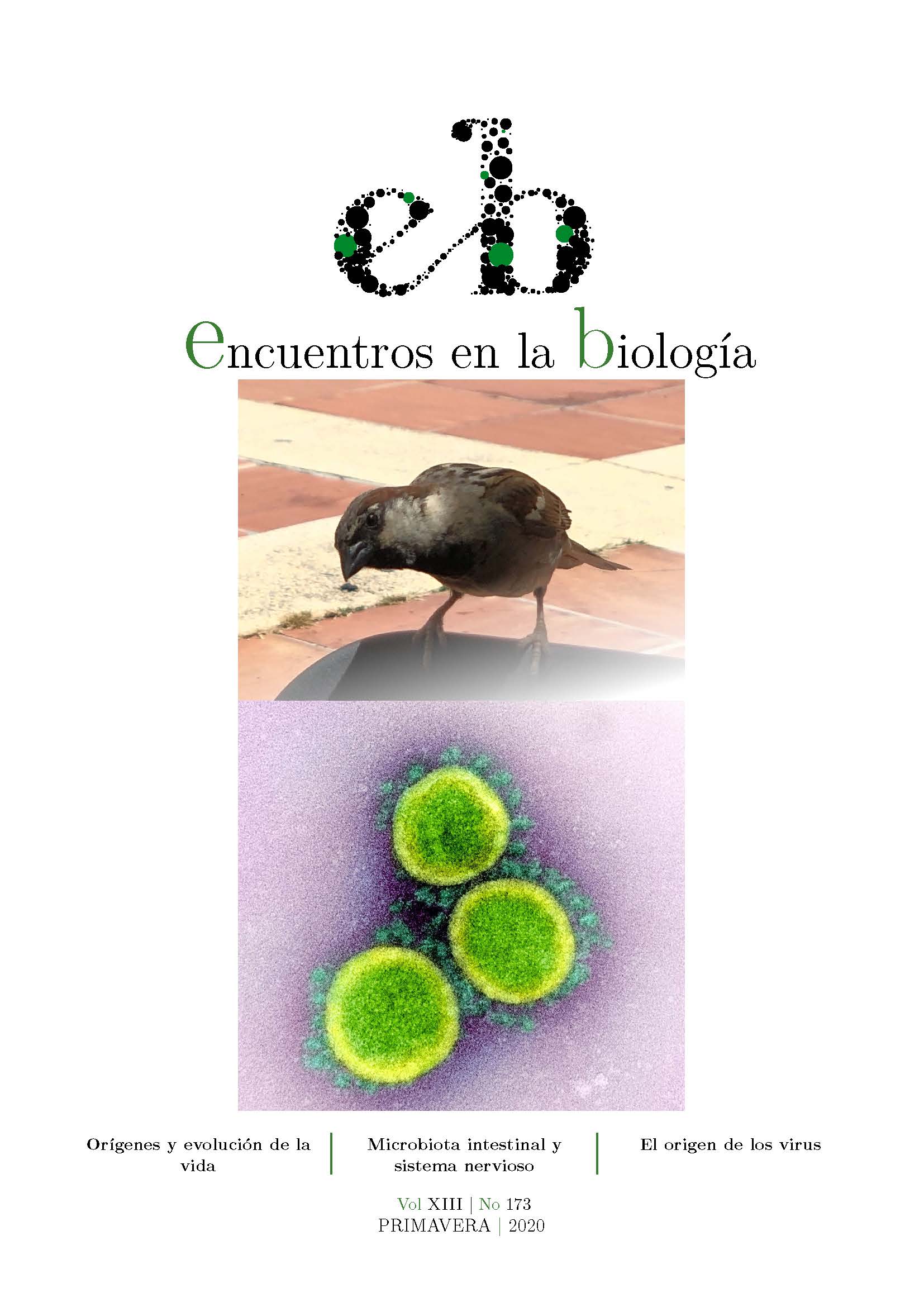The origin of viruses
DOI:
https://doi.org/10.24310/enbio.v13i173.17343Keywords:
virus evolution, RNA world, origin of viruses, mutation rate, giant viruses, fourth domain of life, selfish genetic elementsAbstract
Viruses are the dominant biomolecular entities on Earth and show a much higher genetic diversity than all known cellular life forms. Despite the knowledge obtained about the molecular properties of viruses and how they hijack the cellular machinery to multiply and spread out, causing diseases of great clinical importance such as HIV or Ebola, little is known about their origins. This article is a on End-of-Degree Project has aimed to carry out a synthesis of the current state of knowledge about the origin and evolution of viruses.
Downloads
Metrics
Publication Facts
Reviewer profiles N/A
Author statements
Indexed in
-
—
- Academic society
- N/A
- Publisher
- Uma Editorial. Universidad de Málaga
References
Patel, M. R., Emerman, M. y Malik, H. S (2012). Paleovirology- Ghosts and gifts of the past. Current Opinion in Virology, 1: 304–309.
Feschotte, C. y Gilbert, C. (2012). Endogenous viruses: Insights into viral evolution and impact on host biology. Nature Reviews Genetics, 13: 283–296.
Holmes, E. C (2011). What Does Virus Evolution Tell Us about Virus Origins? Journal of Virology, 85: 5247–5251.
Flores, R., Sanjuán, R., Gago-Zachert, S., Elena, S. F. y Serra,P. (2014). Viroids: Survivors from the RNA World? Annual Re- view of Microbiology, 68, 395–414.
Prangishvili, D. y otros (2017). The enigmatic archaeal virosphe- re. Nature Reviews Microbiology, 15: 724–739.
McCutcheon, J. P. y Moran, N. A (2012). Extreme genome re- duction in symbiotic bacteria. Nature Reviews Microbiology, 10: 13–26.
Nasir, A., Sun, F. J., Kim, K. M. y Caetano-Anollés, G. (2015). Untangling the origin of viruses and their impact on cellular evolution. Annals of the New York Academy of Sciences, 1341: 61–74.
Nasir, A., Kim, K. M. y Caetano-Anollés, G. (2017). Phyloge- netic tracings of proteome size support the gradual accretion of protein structural domains and the early origin of viruses from primordial cells. Frontiers in Microbiology, 8: 1178.
Schulz, F. y otros (2017). Giant viruses with an expanded com- plement of translation system components. Science, 356: 82–85
Krupovic, M. y Koonin, E. V (2017). Multiple origins of vi- ral capsid proteins from cellular ancestors. Proceedings of the National Academy of Science 114: 2401–2410.
Erdmann, S., Tschitschko, B., Zhong, L., Raftery, M. J. y Ca- vicchioli, R. (2017). A plasmid from an Antarctic haloarchaeon uses specialized membrane vesicles to disseminate and infect plasmid-free cells. Nature Microbiology, 2: 1446–1455.
Koonin, E. V., Dolja, V. V. y Krupovic, M. (2015). Origins and evolution of viruses of eukaryotes: The ultimate modula- rity. Virology, 479–480: 2–25.
Dolja, V. V. y otros (2018). Origins and Evolution of the Glo- bal RNA Virome. MBio, 9: e02329-18.
Shi, M. y otros (2016). Redefining the invertebrate RNA vi- rosphere. Nature, 540: 539–543.
Zhang, Y. Z., Wu, W. C., Shi, M. y Holmes, E. C (2018). The diversity, evolution and origins of vertebrate RNA viruses. Cu- rrent Opinion in Virology, 31: 9–16.
Hayward, A. (2017). Origin of the retroviruses: when, where, and how? Current Opinion in Virology, 25: 23–27.
Downloads
Published
How to Cite
Issue
Section
License
Esta obra está bajo licencia internacional Creative Commons Reconocimiento-NoComercial-CompartirIgual 4.0.
Esta revista provee acceso libre inmediato a su contenido bajo el principio de hacer disponible gratuitamente la investigación al público. Todos los contenidos publicados en Encuentros en la Bilogía están sujetos a la licencia Creative Commons Reconocimento-NoComercia-Compartirigual 4.0 cuyo texto completo puede consultar en <http://creativecommons.org/licenses/by-nc-sa/4.0>
Se pueden copiar, usar, difundir, transmitir y exponer públicamente, siempre que:
Se cite la autoría y la fuente original de su publicación (revista, editorial y URL de la obra).
No se usen para fines comerciales.
Se mencione la existencia y especificaciones de esta licencia de uso
Los derechos de autor son de dos clases: morales y patrimoniales. Los derechos morales son prerrogativas perpetuas, irrenunciables, intransferibles, inalienables, inembargables e imprescriptibles. De acuerdo con la legislación de derechos de autor, Encuentros en la Biología reconoce y respeta el derecho moral de los autores/as, así como la titularidad del derecho patrimonial, el cual será cedido a la Universidad de Málaga para su difusión en acceso abierto. Los derechos patrimoniales, se refieren a los beneficios que se obtienen por el uso o divulgación de las obras. Encuentros en la Biología se publica en open access y queda autorizada en exclusiva para realizar o autorizar por cualquier medio el uso, distribución, divulgación, reproducción, adaptación, traducción o transformación de la obra.
Es responsabilidad de los autores/as obtener los permisos necesarios de las imágenes que están sujetas a derechos de autor.
Los autores/as cuyas contribuciones sean aceptadas para su publicación en esta revista conservarán el derecho no exclusivo de utilizar sus contribuciones con fines académicos, de investigación y educativos, incluyendo el auto-archivo o depósito en repositorios de acceso abierto de cualquier tipo.
La edición electrónica de esta revista esta editada por la Editorial de la Universidad de Málaga (UmaEditorial), siendo necesario citar la procedencia en cualquier reproducción parcial o total.






